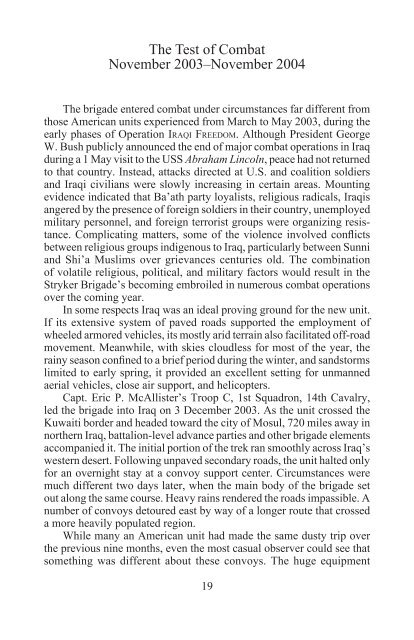From TransFormaTion To CombaT The First stryker brigade at War
From TransFormaTion To CombaT The First stryker brigade at War
From TransFormaTion To CombaT The First stryker brigade at War
Create successful ePaper yourself
Turn your PDF publications into a flip-book with our unique Google optimized e-Paper software.
<strong>The</strong> Test of Comb<strong>at</strong><br />
November 2003–November 2004<br />
<strong>The</strong> <strong>brigade</strong> entered comb<strong>at</strong> under circumstances far different from<br />
those American units experienced from March to May 2003, during the<br />
early phases of Oper<strong>at</strong>ion IraqI Freedom. Although President George<br />
W. Bush publicly announced the end of major comb<strong>at</strong> oper<strong>at</strong>ions in Iraq<br />
during a 1 May visit to the USS Abraham Lincoln, peace had not returned<br />
to th<strong>at</strong> country. Instead, <strong>at</strong>tacks directed <strong>at</strong> U.S. and coalition soldiers<br />
and Iraqi civilians were slowly increasing in certain areas. Mounting<br />
evidence indic<strong>at</strong>ed th<strong>at</strong> Ba’<strong>at</strong>h party loyalists, religious radicals, Iraqis<br />
angered by the presence of foreign soldiers in their country, unemployed<br />
military personnel, and foreign terrorist groups were organizing resistance.<br />
Complic<strong>at</strong>ing m<strong>at</strong>ters, some of the violence involved conflicts<br />
between religious groups indigenous to Iraq, particularly between Sunni<br />
and Shi’a Muslims over grievances centuries old. <strong>The</strong> combin<strong>at</strong>ion<br />
of vol<strong>at</strong>ile religious, political, and military factors would result in the<br />
Stryker Brigade’s becoming embroiled in numerous comb<strong>at</strong> oper<strong>at</strong>ions<br />
over the coming year.<br />
In some respects Iraq was an ideal proving ground for the new unit.<br />
If its extensive system of paved roads supported the employment of<br />
wheeled armored vehicles, its mostly arid terrain also facilit<strong>at</strong>ed off-road<br />
movement. Meanwhile, with skies cloudless for most of the year, the<br />
rainy season confined to a brief period during the winter, and sandstorms<br />
limited to early spring, it provided an excellent setting for unmanned<br />
aerial vehicles, close air support, and helicopters.<br />
Capt. Eric P. McAllister’s Troop C, 1st Squadron, 14th Cavalry,<br />
led the <strong>brigade</strong> into Iraq on 3 December 2003. As the unit crossed the<br />
Kuwaiti border and headed toward the city of Mosul, 720 miles away in<br />
northern Iraq, b<strong>at</strong>talion-level advance parties and other <strong>brigade</strong> elements<br />
accompanied it. <strong>The</strong> initial portion of the trek ran smoothly across Iraq’s<br />
western desert. Following unpaved secondary roads, the unit halted only<br />
for an overnight stay <strong>at</strong> a convoy support center. Circumstances were<br />
much different two days l<strong>at</strong>er, when the main body of the <strong>brigade</strong> set<br />
out along the same course. Heavy rains rendered the roads impassible. A<br />
number of convoys detoured east by way of a longer route th<strong>at</strong> crossed<br />
a more heavily popul<strong>at</strong>ed region.<br />
While many an American unit had made the same dusty trip over<br />
the previous nine months, even the most casual observer could see th<strong>at</strong><br />
something was different about these convoys. <strong>The</strong> huge equipment<br />
19

















